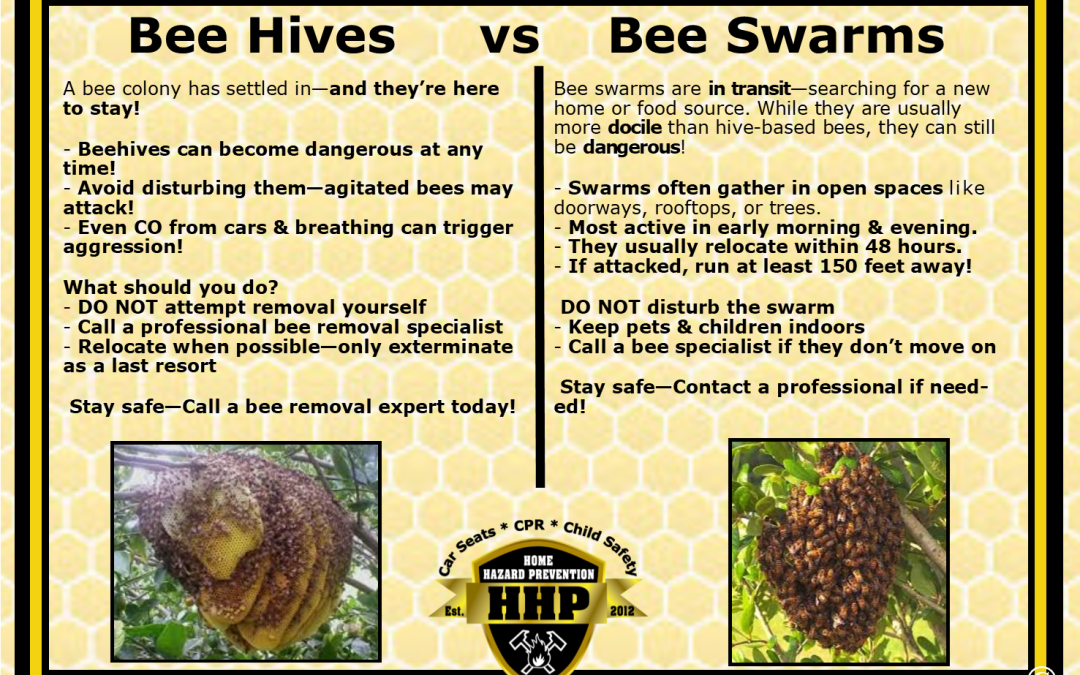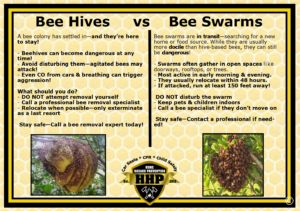Stay Safe and Protect Our Pollinators!
Spring is just around the corner! As the wildflowers bloom in all their colorful glory, another vital part of our ecosystem comes buzzing back to life—bees. These tiny, hardworking creatures are essential to our environment and economy, pollinating the flowers, fruits, and crops that sustain life as we know it.
But with their return also comes a responsibility: knowing how to coexist with bees safely. While they are generally harmless, they will defend themselves when provoked. Understanding how to avoid unnecessary encounters and what to do if you find yourself in their path is key to ensuring safety for both humans and bees.
The Buzz on Bee Safety
Bees can be everywhere, and sometimes, encounters happen at inopportune moments. If you find yourself near a bee or a cluster of bees, follow these essential safety tips:
- Back away slowly. Sudden movements can startle bees, making them feel threatened.
- Stay quiet and breathe lightly. Loud noises and heavy breathing can agitate them.
- Never swat at a bee. This will make them feel attacked and more likely to sting.
- If bees become aggressive, run at least 150 feet away. Unlike wasps, most bees can only sting once, but when provoked, they will defend their hive fiercely.
Why We Need to Protect Bees
Bees are in serious decline, and their loss would have devastating effects on our environment and economy. Experts warn that rapid extermination of local bee populations can impact an area’s economy within just two years. A worldwide collapse of bee colonies could lead to global food shortages within five years.
No bees = No pollination = No plants = No food for animals = No food for us.
The best way to protect both yourself and these critical pollinators is by leaving them alone whenever possible. If a beehive is a concern, professional bee removal is the safest and most effective solution.
Swarm vs. Hive: Know the Difference
When reporting bees to a removal specialist, it helps to know whether you’re dealing with a swarm or a hive:
- A swarm is a tight cluster of bees, usually hanging from a tree branch or a flat surface. Swarms are typically temporary and easier for professionals to relocate.
- A hive is a more permanent structure, featuring honeycomb and a long-term bee population. Hives require expert relocation to ensure safety.
If you encounter a swarm or hive, don’t panic—contact a local bee removal specialist instead of exterminating them. Relocating bees keeps our environment healthy and thriving!
What About the Fire Department?
Many people instinctively call the fire department when they see bees, but in most cases, this is unnecessary. Firefighters will not destroy bee colonies unless there is an immediate threat to human life. Attempting to exterminate bees with special foam is often ineffective, eliminating only about 20% of the population while angering the rest. This can make the situation even more dangerous for nearby residents.
Your best bet? Call a bee removal specialist first. This ensures the safety of both the bees and your community.
Home Hazard Prevention Is Here to Help!
At Home Hazard Prevention, we believe that safety starts with education and preparation. As your trusted Fire and Life Safety Experts, we are dedicated to protecting your home, family, and business with expert advice and hands-on training.
Have questions or need safety training? Contact us today!
🔹 Mobile CPR Training 🔹 Car Seat Education 🔹 Infant & Home Safety 🔹 And much more!
(480) 448-0266
Nick@HomeHazardPrevention.com
Let’s work together to make our communities safer—one bee, one home, and one life at a time.
#######
For expert firefighter-led safety solutions, trust Home Hazard Prevention to keep your family and business protected. Whether its CPR training, car seat education, or home hazard prevention, “Safety Nick” and his team are here to help-affordably and conveniently. Because when it comes to safety, experience matters! Contact Home Hazard Prevention today at (480) 448-0266 or Nick@HomeHazardPrevention.com
© HHP, LLC 2012-2025


